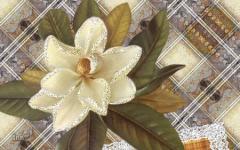Unfortunately, there is no single answer to your question. The situation is this:
The old Soviet SNiP III-28-75, long canceled, ordered the hot water pipe to be located to the right of the mixer, and the cold one to the left. This requirement is absent in the existing joint ventures, but in the technological maps and instructions for the production and acceptance of work from 2011 it is mentioned that with parallel vertical laying, as a rule, hot water should be located on the right. And at horizontal - from above. That is, the recommendations of the times of the USSR in general view are preserved and most of the bathrooms are still equipped with them. However, the clause “as a rule” makes compliance with these standards optional; if justified, you can change the relative position of the hot and cold water pipes. What is the logic of cold water on the left and hot on the right? Domestic standard-setters believe: in order to reduce the likelihood of getting burned by hot water, the valve for adjusting it should be located on the right. If suddenly boiling water comes out of the tap, the average person will be able to reduce the flow faster, because there are more right-handers than left-handers.

Domestic standard for connecting a mixer. Right - valve hot water
Opinions were divided abroad. There are countries in which, like ours, a pipe and a hot water valve are placed on the right, but they are in the minority. More often they do the opposite: cold on the right, hot on the left. They explain it this way: in order not to get burned, you must first turn on cold water, and only then gradually add hot water. Most people make the first movement with their right hand, so it is more convenient when the right hand is cold.

In most foreign countries, it is customary to connect cold water on the right
In our opinion, from the point of view of convenience, there is no difference where which pipe and valve are located. Moreover, lever mixers are more relevant today. The main thing is that within your home all the mixers are connected in the same way, then you will never get confused.
The nature of the location of the water pipes does not affect the operation of a conventional (non-thermostatic) mixer.

For a standard faucet, it does not matter on which side the cold or hot valve is placed. This does not affect the function, and the plugs with the inscriptions "Hot" and "Cold" are easy to swap
What to prefer? In our opinion, although this contradicts domestic recommendations, cold water should be connected to the right, and hot water to the left. And that's why:
- All faucets from the EEC countries and China (the lion's share of imports) with a thermostat are fully operational only when cold water is connected on the right, hot on the left. Even if you don't have such a faucet today, who knows if you might want to have one tomorrow?

In mixers with a thermostat, the location of the hot and cold water connection must not be arbitrarily changed. Water, of course, will go, but it will not be possible to adequately regulate its temperature.
- Almost all electric water heaters are also connected according to the "cold right" scheme. This does not affect mixers in any way, but it is still more convenient to use and repair when all pipes are oriented in the same way.

In boilers, cold is also on the right. If you confuse the connection, “warm will go”, but the efficiency of the water heater will noticeably decrease
Independent wiring of hot and cold water pipes in an apartment or house is not an easy task, but real. Even if you are going to hire a specialist, you should know the main points yourself - control will not hurt.
Today, in most cases, piping in the bathroom is made of polymer pipes - polypropylene for plumbing, PVC for sewage
How to develop a plumbing layout
First, determine the places where all consumers of cold and hot water will be located. It is better to do everything on the plan, but you can also mark it “on the spot”. Not only the geometric dimensions of the devices are important, but also the exact location of the place where the water must be brought.

Draw a plan with dimensions and distances - the first step
Many devices are connected to the water supply network using flexible hoses. Then the outlet from the line can end 10-20 cm before the device. The main thing is that the connection point is easily accessible. This is necessary for convenient and fast connection maintenance. This connection method is easier to implement - there is no need to accurately calculate the length of the pipe.
There is also a hard water supply to plumbing fixtures or household appliances - pipes to the very entrance. Such a connection is more difficult to perform, therefore this type of wiring is less common. Basically, gas water heaters (columns), bathroom faucets that are attached to the wall are connected this way.
Outdoor or concealed laying
First of all, it is worth deciding on the type of pipe laying - will they go on top or hidden in a wall or floor. Hidden wiring in the bathroom, toilet is good from an aesthetic point of view - nothing is visible. But the pipes are not available, to fix the leak you will have to break the wall, which is not at all pleasing. Therefore, they try to lay only whole pieces without joints in the wall - there is less chance of leakage.

There is another difficulty with the hidden laying of water supply - the need for channels in the wall (strobe) into which pipes are laid. Firstly, not every wall allows you to make strobes in it. For example, in panel houses, where the wall thickness is only about 10 cm, it is definitely not worth making a channel 5-6 cm deep. The slab will lose a significant part of its bearing capacity. What it threatens to explain, probably, it is not necessary. Secondly, laying a strobe in the wall is not the easiest job, even with a puncher it takes a lot of time. So there are more than enough cons for this option.
Another type of hidden pipe connection is behind a false wall. To do this, stepping back some distance from the main wall, a frame is installed, and drywall is placed on it, on which tiles are then laid. The second option for false walls is made of plastic panels.

From a practical point of view, external piping is better - everything is in sight, available for repair at any time. But the aesthetic side suffers. To hide communications, all of them - water supply and sewerage - are trying to lay closer to the floor, then they build on a plasterboard box with a removable lid or top. So all the pipes have free access, and they themselves are almost invisible.

Laying method
In an apartment or house, plumbing is done in two ways - by connecting all consumers in series or by installing a collector, from which a separate pipe goes to each of the devices. Both options are not without drawbacks.
When pipes are connected in series, it takes little, but if more than two plumbing fixtures are connected in a row, the pressure may be insufficient when they work simultaneously. This type of wiring is also called a tee - all branches from the main main pipe are made using tees (sometimes crosses or corners).

With the collector wiring of the water supply system, a lot of pipes go away, in addition, additional equipment is required - a collector for the water supply system. So this piping scheme is an expensive undertaking, but the pressure on all connected devices, regardless of the number of workers, is the same.

Parallel connection - each device has its own line from the collector
There is one more nuance: a large number of pipes have to be laid somewhere, and compactly, and this is not at all easy. Therefore, this type of wiring is more often used for hidden or open laying, but in those places that require such a connection or can be closed by furniture.
For example, in a bathroom or toilet, only two devices are connected. There you can do serial wiring. In the kitchen, a column (boiler), a sink faucet, a washing machine and a dishwasher are connected. In this case, it makes sense to put a collector in the kitchen, and from it separate branches of water supply to all consumers. This connection method is called mixed - part of the water supply is diluted with tees, part - from the collector.

Please note that if cold and hot water are distributed at the same time, the pipelines are laid in parallel. With a hidden liner, it makes sense to wrap the DHW liner in thermal insulation - then the water will really be hot and you will not heat the walls. If the pipes are polypropylene or plastic, this is not so critical - polymers have a low heat transfer coefficient. For metal (any - steel, stainless steel, galvanized, copper), thermal insulation is very desirable.
Piping: rules
As in any business, plumbing has its own rules. They are also used for plumbing. If you are going to do the plumbing for yourself, it’s up to you to follow them or not, but it’s better to do everything right. The rules have their own logic, which is followed by the majority:

If you look closely, you will see that most of the water pipes are made according to these rules.
Which plumbing pipes are best
It is impossible to say unequivocally which pipes are best for wiring - there is no ideal material, there are more or less suitable for these conditions. Let's dwell on the most popular options, their advantages and disadvantages:
Polypropylene pipes
The option is good for everyone, except for a large thermal expansion - up to 5 cm per 1 meter, and this is a lot. With a long route, it is necessary to install a compensator or use reinforced pipes. They have much less thermal expansion, but the prices are higher. For hot water, it is definitely necessary to use reinforced pipes, but with fiberglass or foil - it's up to you. The distribution of cold water pipes can be done with a conventional PPR pipe for cold water - here thermal expansion is not so critical.
![]()
Polypropylene pipes for plumbing - an excellent choice
Another point that is relevant if you do the work yourself, you are going to do a hidden laying of communications - the quality of the connections. In principle, there is nothing complicated, but without experience you can “screw up”, as a result, after a while the connection may leak. In the absence of experience in welding polypropylene, it is very undesirable to hide the joints under the finish. In this case, it is better to choose an open laying method.
The layout of polypropylene pipes in the bathroom and toilet has many positive aspects:
- a correctly made connection turns out to be monolithic;
- there is no narrowing of the pipeline diameters in the places of soldering;
- high maintainability;
- long service life;
- ease of installation.
In general, it is not for nothing that this material has been so popular lately.
PVC for plumbing
When wiring PVC pipes adhesive bonding is used. There is a special glue that dissolves the top layer of the polymer. Both parts to be glued are lubricated with it, pressed against one another and held for some time. As a result, the connection is almost monolithic, strong and reliable.

There are two types of connection: butt, when two pipe sections are joined and using fittings. Fittings are easier to work with, but the joints are narrower. With a butt joint, there are no narrowings, but it is much more difficult to make it qualitatively.
In principle, all the pros and cons are the same here, a few minuses are added - it is only suitable for transporting cold environments - no more than + 40 ° C, that is, other pipes will have to be used for hot water supply. Scratches and chips reduce the strength of the pipe, therefore, a threaded connection is excluded.
metal-plastic
The layout of the water supply from metal-plastic pipes is also suitable for hot water supply - it can withstand temperatures up to + 105 ° C. A positive difference from all of the above is its high plasticity - these pipes can be bent with a fairly small radius. This simplifies and reduces the cost of installation (fittings are expensive).

Metal-plastic - not the best choice
The disadvantage of using metal-plastic pipes for plumbing is a strong narrowing at the joints - in fittings. This results in a significant pressure drop in the system. This is what limits their use.
Circuit examples
The piping in each apartment, even in a typical house, is individual - plumbing and household appliances are arranged differently, of course, the scheme will be different. In reality, everything is not so complicated, you just need to decide on the main parameters of the circuit - where you need to supply water and the type of wiring - will you pull in parallel or in series. Further, everything is dictated by the position of consumers. To make it a little easier, let's add a few more diagrams and photos.

The peculiarity of this scheme is that a thicker pipe from the hot water supply goes to the heated towel rail. This is done to ensure the best heating.

Example of serial wiring - equipment at the entrance to the apartment to increase security


With hidden installation of water pipes, part of the pipes can be hidden in the floor. It will be impossible to repair them, but they are beautiful ...



A way to hide the pipes in the bathroom, laid along the wall
From which side to supply hot water, and from which cold? A small question, which is talked about in passing everywhere. Let's figure it out.
For the impatient: hot - on the left, cold - right.
And now in more detail.
Often plumbers (especially the old school) insist that hot water should be on the right. Where did they get it from? Probably from the USSR. And although there were no strict regulations, there was still SNiP III-28-75 of 1976 (link to PDF, p. 25) with the wording:
3.27 Hot water pipes are located, as a rule, to the right of cold water risers.
Apparently from there, the conviction came from that the hot one should be on the right. But SNiP is no longer valid, and the current GOST 25809-96 does not regulate the issue of the location of cranes:
3.3 The shape and design of faucet and faucet bodies, water switches, spouts, aerators, shower pipes, hoses, shower nets, brushes, valve heads or handles, parts for connecting faucets and faucets to cold and hot water networks, attaching shower screens to the wall or on the mixer body are not regulated by this standard, but are determined by the working drawings.
As you can see, GOST leaves the choice to the drawings. The fact is that in some building projects, openings and entrances are located in such a way that hot water will have to be made on the right.
Nevertheless, all over the world they try to arrange hot water so that it is less convenient to open it than cold water. Those. left. And this makes sense.
Most people are right-handed. In an emergency (wash hands or eyes from getting any chemicals), a person reaches for the faucet with his right hand. It is safer to have cold water at hand (the poor fellow was not enough to get burned).
In addition, all modern mixers are equipped this way (hot - on the left, cold - on the right). And mixers with a thermostat cannot be mounted at all, except: cold - on the right. But to find a mixer with a thermostat so that there is hot water on the right - this still needs to be tried. Perhaps under the order ... but it is doubtful.
Another quote from Donald A. Norman from The Design of Everyday Things:
All over the world it is customary to have a valve for hot water on the left, and for cold water on the right. It is also universal that they are twisted clockwise, and unscrewed - against.
In the book The Design of Everyday Things by Donald Norman, it is said that bad design of a thing can make it not obvious or even impossible to use it. As an example, he cites a glass door, by the appearance of which it is impossible to understand how to open it - pull or push. Norman calls to observe the things around us and the habits associated with the use of these things. If you couldn't figure out how to use a thing, you shouldn't blame yourself, but the poor design of the thing, says Norman.
Reflecting on this topic, I remembered the subject, with the use of which I, and probably not only me, have difficulties. Although, it would seem, the thing is nowhere simpler. This is a simple tap faucet. The most common mixer looks like this:
What is so difficult, you ask? Red faucet for hot water, blue for cold. Well, or usually signed, cold or hot, red or blue, he or tse. However, I continue to burn myself with water and perform the temperature adjustment ritual:
1. Open the faucet
2. Taste the water
3. Oh fuck, hot
4. Add cold
5. Brr fucking cold
6. Reduce cold
7. Oh fuck you can wash your hands
That is, each time I determine which of the taps controls hot water experimentally. Why? It would seem that the color of the faucet handles should indicate the temperature. But for some reason in our country this is often not the case. Our plumber, when installing the faucet, wanted to give a shit about ensuring that the information on the faucet corresponded to the supplied water. He needs to do the work, put the mixer. And this happens so often that I have developed the habit of experimentally checking which side is hot and which is cold water. Wherever I go, the mixer taps are mixed up everywhere and I don’t even notice what is written on the tap. It's easier to just start experimenting.
Now the mixer with one handle back and forth is more common. And here the designers, apparently, have ceased to bathe at all. Here is a faucet installed in the toilet at my work, try to guess from which side the hot water is:

The designer decided that it makes no sense at all to report where the water is. Opened in the center and order! You need hot water, well, check on the right or left, your problems.
For some reason, logic tells me that it should always be cold on the left, and hot on the right. Just like the past is meant on the left, the future on the right, good on top and evil on the bottom. But faucet designers think deeper. Most European faucets, such as the one in photo 2, assume the hot tap (or tap position) is on the right. It is believed that most Europeans are right-handed, and, going to the sink, they grab the right faucet or move the lever to the right. And in order to reduce the number of people burned with boiling water, a cold tap is usually placed on the right. But for some reason, at my work and at home, the opposite is true - hot water is on the right. Who is right?
Don Norman believes that you should not criticize anything until you can provide a solution to the problem.
So, we have the task - to make sure that the tap makes it clear to the person which side the hot water is from. Exclude the option when the tap is marked red, and the water flows from this side cold.
A fantastic solution immediately comes to mind - you need to make sure that the mixer itself determines the temperature of the water. Of course, everything has already been invented before us. Here's what Google shows us:

But let's take a closer look at all these faucets that illuminate the water. None of them solve the problem. For some reason, they all highlight the water in the color of the temperature, but it's still not clear to me in which direction the tap should be turned to make the water warmer. Also, green or blue water doesn't make me want to drink it, but that's another matter.
Obviously, it is necessary to highlight not the water, but the indicator! It is necessary that, depending on the temperature of the water in the side connected to a certain side (inlet, flange, I don’t know), the indicator changes, showing which side is hot. And even if a drunk plumber attached the pipes in reverse, there will be no problems.
This solution has a lot of disadvantages: a significant complication of the design, the need to have a power source and the most main disadvantage- when the tap is not opened for a long time, the water in the hot water pipe cools down, the indicator fixes this and shows that the water is cold on both sides, which means that the whole point of the device is lost. We brush aside.
There should be an easier solution.
1. Removable indicator. Well, that is, the red and blue marks on the tap or the red-blue circle should be removable. The plumber mixed up the taps - swapped the labels and order. The disadvantage is that a plumbing error is not ruled out. In addition, perhaps some perfectionists need hot water to be always on the right or left.
2. Paint the water inlets on the invisible side of the faucet red and blue colors. A plumber, when he lies under the sink and installs pipes, does not see which side is which tap, and if the water inlets were tinted, it would be clearer. This solution eliminates the cause of the problem - the plumber's mistake. Of course, the master can mix up the pipes, but there's nothing to be done, the apartments are different, each case is unique, sometimes you need to think with your head.
Let's draw a line:
1. The hot / cold water indicator must always be present
2. If the pointer is not removable, the design of the faucet on the part of the master must clearly indicate from which side hot / cold water is connected.
3. By default, the cold faucet should be on the right.
Interestingly, before there were no faucets at all, and even now, in England and in some other countries, there are sinks and bathrooms with separate taps for hot and cold water. Although now it is done rather out of economy or to imitate the classic style.

It is not convenient to wash your hands without a mixer and it is not convenient to regulate the temperature of the water in the bath too. Yes, and taps can still be confused.
What side do you have hot water on? Are you testing the temperature? Were you burned often?
UPD. They sent a photo from Penza. Hot water, they say, on the right:










